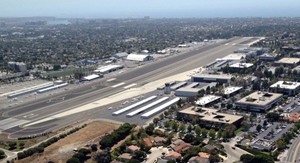 Voters agree to leave fate of Santa Monica Airport to City Council Westside Today
Voters agree to leave fate of Santa Monica Airport to City Council Westside Today
In a step that could move Santa Monica Airport closer to closure, voters agreed to allow the City Council to make decisions regarding the fate of the airfield and rejected an effort by aviation groups to require a public vote on any effort to shutter the facility or restrict aviation activity.
Although city officials are still in a power struggle with the federal government over the future of the 227-acre airport, passage of Measure LC on Tuesday’s ballot gave the City Council a vote of confidence from residents.
Members of the Santa Monica City Council are considering closing all or part of the airport and have already implemented or want to enact measures to restrict airplane traffic, such as limiting fuel use and noise levels.
Under Measure LC, if the airport is indeed closed, the land can only be developed into public parks, recreational facilities or open space. If any other types of development are planned, the city will be required to seek voter approval.
The proponents of Measure LC said noise and air pollution created by the Santa Monica Airport has increased by 350 percent over the years. They also said 26 airplanes affiliated with the airport have crashed, resulting in 36 deaths, since 2000.
While passing LC, voters also defeated Measure D, under which any plans to completely or partially close the airport or to restrict activity would have required a public vote. Backers of the measure contended that city officials want to put high-rises or other dense housing development on the property, which would increase traffic and air pollution.
They also argued that any proposal to close or limit activity at the airport would affect 175 businesses and 1,500 jobs. The airport also injects $250 million into the economy each year, according to Measure D proponents.
Backers of Measure LC argued, however, that the legal language of Measure D would have prevented city officials from controlling airport activity, such as limiting fuel use and the frequency or hours of take-offs and landings.
Measure D was heavily backed by aviation groups, including the Aircraft Owners and Pilots Association and the National Business Aviation Association, which together donated at least $540,000 of the $824,000 raised by proponents.
Actor Harrison Ford, a noted aviation enthusiast, contributed $25,887 to the Measure D campaign.
City officials are still trying to overturn an agreement the city reached with the federal government in 1948 – when the airport was returned to Santa Monica after World War II – that restricts the land to being used as an airport. City officials contend that the city bought the land in the 1920s to use as parkland.
The airport does not offer scheduled air service but is used for flight training, recreational and private transport and other purposes.
